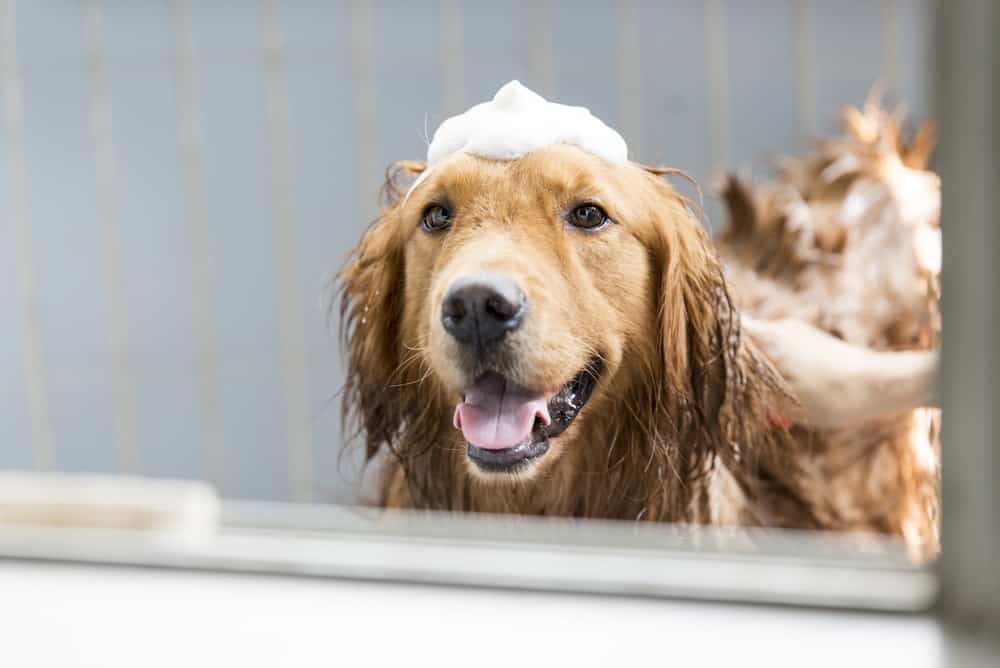“This post contains affiliate links, and I will be compensated if you make a purchase after clicking on my links.”
Does your dog make your nose run, eyes itch, and otherwise send your allergies into overdrive? Fortunately, there are some simple things you can do to reduce the effect of allergies – and they don’t involve your furry friend going anywhere!

Contrary to popular belief, pet hair rarely causes an allergic reaction. Instead, it’s pet dander – microscopic flecks of your dog’s skin – that are the issue.
The five following cleaning techniques reduce the presence of pet dander around the house, helping to minimize the effects of pet allergies. They won’t stop allergies completely but can make a noticeable difference to many people’s symptoms.
1. Practice Good Hygiene
The first tip focuses on keeping both you and your dog clean. Always wash your hands after touching your dog. Pet allergens can transfer from your hands to your face, where they can activate your allergies. Fortunately, soap and water will wash these allergens away.
Also, keep your dog well-groomed. Ask a non-allergic member of the family to give your pet a regular brush, as this removes loose hair and dander that would otherwise fall off in the house.
Bathing your dog in plain water is also a great way to remove dander before it can become an issue. Overbathing can cause a dog’s skin to dry out, however, so it’s important not to wash your dog too frequently.

2. Minimize Dander in Carpets, Bedding and Fabrics
Sofas, bedding, and carpets can become reservoirs for allergens. Every time they are disturbed, large quantities of dander is released into the air, leading to allergic reactions even if you’re being as hygienic as possible.
The best way to reduce this effect is to replace carpets with hard floors. These are easier to clean and don’t hold dander in the same way as carpets.
Of course, not everyone likes the thought of swapping carpets for hardwood floors. If this isn’t an option, make sure you vacuum carpets regularly and use a pet tool on upholstery. It’s also vital to wash your dog’s bedding regularly.
Bonus Tip for Removing Pet Hair
Do you have pet hair covering your furniture, carpets, and bedding? Remove it with duct tape! It’s an easy and efficient way to collect loose pet hair.
Wrap duct tape (with the sticky side facing out) around a paint roller to create a custom hair removal tool. Roll it across any surface in your house, including upholstery and carpets. Replace the tape as necessary once it becomes covered in hair.
3. Create a Pet-Free Zone
Designate one room in your home as a “pet-free zone,” which means your dog isn’t allowed in. Typically, the allergic person’s bedroom is a good option because it allows them to sleep comfortably.
Set up an air purifier in the room to filter out allergens. Also, wash all the linens in the room, such as sheets and pillowcases, on a weekly basis. Finally, keep the door closed at all times so allergens from the rest of the house don’t drift in.
Even if you enjoy sleeping in the same room as your pet, having eight hours of reduced allergen exposure is nearly always worth the trade-off.
4. Ask Other Family Members to Clean the Home
Dusting, vacuuming, mopping, and washing are all essential for reducing the amount of dander in the home. The more you clean, the less dander there is to trigger a reaction.

Unfortunately, cleaning also stirs up dander, which can increase symptoms in the short term. Dusting is particularly bad for this, although any cleaning is likely to temporarily cause more allergens to float in the air.
The best solution is to ask another family member to do the vacuuming and dusting while you’re not at home. Make sure they also empty the vacuum outside and wash any dusting cloths before you return.
5. Use a Pet Vacuum With an Effective Filter
For best results, you’ll want a pet vacuum with a High-Efficiency Particulate Air (HEPA) filter. This is a pleated mechanical air filter that captures small particles, such as pet allergens. Without a HEPA filter, your vacuum might only stir allergens up and spread them around the house instead of trapping them.
HEPA filters are rated according to their Minimum Efficiency Reporting Values (MERVs). The higher the MERV rating, the smaller the particles the filter can capture. MERV ratings vary from one to 16. Any filter with a rating between nine and 12 will typically work well for removing allergens in a residential home.
Aside from a HEPA filter, you’ll want a vacuum with the following characteristics:
- Range of Attachments – These allow you to reach into corners and other tight spots where dander might gather.
- Turbo Brush – These are powered attachments used to clean upholstery and stairs. A turbo brush is essential for removing more hair and dander.
- Bagged Design – Bags are more effective at retaining allergens, especially when emptying the vacuum cleaner. While bagless vacuums are more convenient and save money on bags, they are difficult to empty without allowing dander to escape.
You may also want to consider a vacuum with a charcoal filter. These won’t reduce allergens in the air but can absorb bad pet odors to leave your house smelling fresh and clean.
Final Thoughts
Pet allergies are no fun, but as long as you commit to regular cleaning around the house, you can minimize their effect. Keep your dog well-groomed, use specialized cleaning methods that target pet dander, and buy a high-quality vacuum with a HEPA filter.
With the proper cleaning strategies in place, you and your dog can live together in health and harmony! Of course, you should also talk to your doctor about any allergies, as there may be medical treatments that can help.























